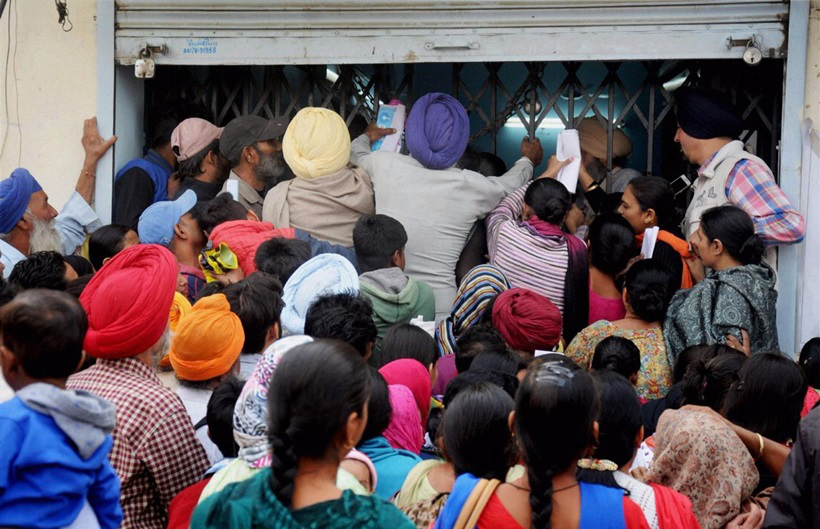PTI photo
By
Jose Kalathil
India, Asia’s third-largest economy, is facing an unprecedented financial emergency after Indian Prime Minister, Narendra Modi, demonetised the most popular high-value Indian currencies with effect from 8 November.
In a telecast on the day, Modi announced that all high value notes in denominations of Rs 500 ($7.40) and Rs 1,000 ($14.70) would be illegal in the country, which formed 86% of the currency in circulation by value in the country. He also announced that one could exchange such devalued notes until December 30 in banks and post offices. He clarified that he took the strong decision to end corruption, black money, and fake currency that often finance terror.
But panicked people are queuing up outside banks to exchange notes and ATMs to withdraw notes without much success as the new Rs 2000 denomination notes are in short supply, the majority of ATMs closed. But the most affected are the poor, who have no bank accounts to deposit the money and are unsure of what to do with these banned notes. “My employer gave me my last month’s salary of Rs 8,000 yesterday, which became without value the next day. How will I feed my family of four, including two children,” asked Aarti Yadav, a saleswoman in a garment shop. She has no bank accounts to deposit money. In order to exchange the devalued money with new notes, she has to stand in long queues taking a day’s leave, but unsure that she would get the new currency as they are in short supply.
The decision will also raise the prices of essential commodities as a large number of trucks have not brought supplies for the last many days. The All India Motor Transport Congress (AIMTC) claims that about 2 lakh trucks have not reached Delhi-National Capital Region. “Trucks that were supposed to enter Delhi four days ago have not reached as yet. Supply of essential items like milk, vegetables, fruits, etc, will get affected,”said Bhim Wadhwa, president of AIMTC.
Cash-strapped consumers are finding it difficult to buy items of daily use such as groceries, medicines, vegetables, etc, as the small denomination notes of Rs 100, Rs 50, Rs 20, Rs 10 and Rs 5 in circulation are not enough. Modi however expects that the decision would help more people disclose their real incomes and pay taxes, which is good for the government’s coffers. (Only about 1% of the country’s population pays income tax currently). It is expected that the clampdown on unaccounted cash could bring in as much as $45 billion for the government, which would help Modi spend more on education, health, and housing.
The decision is expected however to help fight India’s liquidity problems. Some Rs 1.5 lakh crore ($22 billion) in deposits have been collected since the demonetisation announcement. Banks can use these funds to address their liquidity requirements.
Meanwhile, digital mobile wallet firm, Paytm, and call taxis like Ola and Uber, saw a surge in new registrations as people moved from cash to digital payments. Within 15 hours of Modi’s announcement, Ola saw an increase of 15 times in recharge volumes on its e-wallet. Cash-on-delivery transactions, costly and time-consuming for e-commerce retailers, might at least temporarily drop.
Small and medium-size businesses are finding it difficult to pay daily wages and raw material costs, among other expenses. (Indian small businesses typically rely heavily on cash for their day-to-day operations.) The government on November 14 tweaked certain rules and increased withdrawal and deposit caps.
The present scenario proves that the government has not taken enough measures to handle the deposits and withdrawals that were expected following the announcement. Some question the timing of the move alleging political motivations, particularly with some key states preparing for elections. It is important for the ruling Bharatiya Janata Party (BJP) to win them if it is to continue to show its strength in the country. Modi has sought 50 days time to solve the present crisis.
The government has allowed some public utilities like railways, metro system, telephones, electricity to accept the old notes for a week. So, those with the now-invalid notes book expensive train tickets, cancel them, and get refunded in new notes, which has now been banned.
Gold prices increased as many people with undeclared income rushed to buy gold soon after the announcement.
Weddings are getting postponed as bills to wedding halls, florists, and caterers are typically paid in cash.
The long queues at banks and ATMs have turned fatal too. There have also been suicides reported. In the state of West Bengal, a man allegedly murdered his wife after she returned home from the ATM with no money; reports indicated that he expected her to wait in the queue longer.
Doctors have denied treatment to patients as they had only Rs 500 and Rs 1,000 notes. In one state, the family of a three-year-old rape victim reportedly had trouble getting an ambulance driver to take her to the hospital as he allegedly refused to accept the banned currency.
This is not the first time in independent India that the government has demonetised currency notes. A similar exercise was conducted in 1978 under Prime Minister Morarji Desai when the government discontinued the circulation of Rs 1,000, Rs 5,000 and Rs 10,000 notes.
The then Finance Minister H M Patel and the then Reserve Bank of India Governor I G Patel oversaw the demonetisation exercise.
According to reports, gold, commodity and diamond prices had slumped between 5% and 10% within a week of the announcement. Parliament had enacted the High Denomination Bank Notes (Demonetisation) Act in 1978 to cease the circulation of the currency notes.
The availability of high denomination banknotes facilitates the illicit transfer of money for financing transactions which are harmful to the national economy or which are for illegal purposes,” read the preamble of the Act stating the reasons for taking the step.
In 1998, the NDA government had amended the law to reintroduce the Rs 1,000 note.
Prior to Independence, demonetisation was carried out in 1946 when the government had decided to discontinue Rs 10,000 notes that were introduced in 1938.
More recently, in January 2014, the Centre had announced the discontinuation of all banknotes printed before 2005 as the RBI introduced notes with more security features.



India has been failing in good governance since independence from the British. India was created by the British by merging several sovereign states. All races had to struggle for independence under the leadership of M Gandhi and they believed their life will prosper under their local leaders but it has become worse years to come. Now many races start struggling against British formed Indian rule for their sovereignty, rule of law, democracy and independence as Indian Centre rule is highly corrupt, unable to rule with good governance, no significant improvement to 300 million (approx) untouchables, no respect human rights and democratic vales. Thanks to social media that brought changes in the US election recently and hopefully will bring changes to Indian politics as leaders continue to fail their voters. India while boasting as a democracy, it is failing to be democratic as corrupt practices widely used to win votes and democracy will never be successful where there is mass illiteracy. M Gandhi struggle for independence has created so much pain for many races and generations as they truly lost their fundamental rights that they enjoyed under the British.